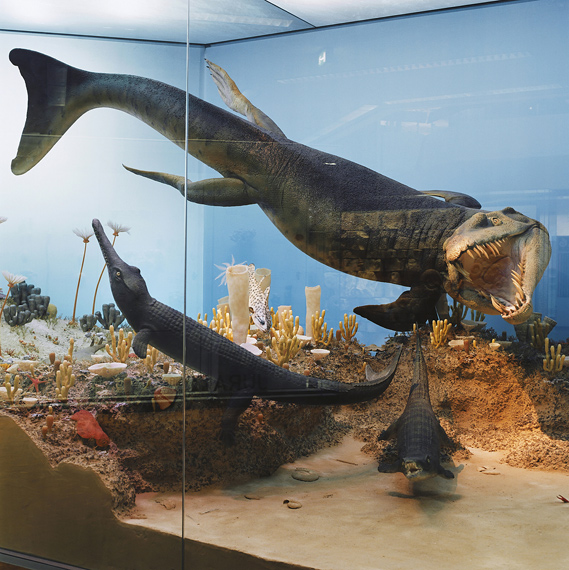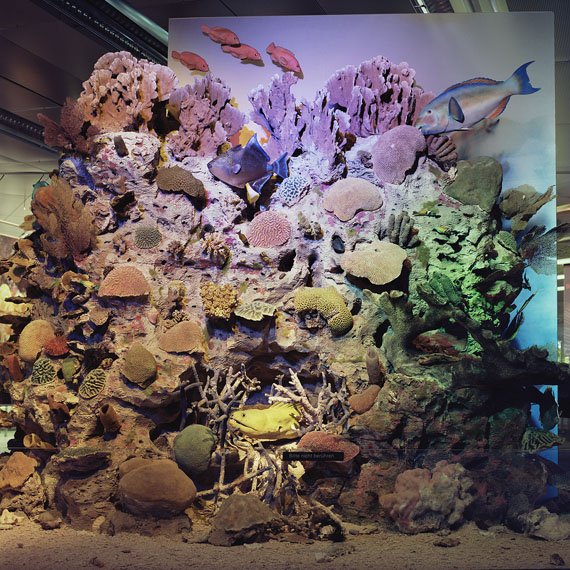
© Roselyne Titaud, 2019
The Lobster Quadrille
Die Hummer-Quadrille
Herbert Bayer » Jim Dine » Ruth Hallensleben » Willi Moegle » Roselyne Titaud »
Exhibition: 6 May – 21 Jul 2019
Sun 5 May 14:00
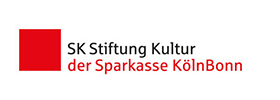
Die Photographische Sammlung / SK Stiftung Kultur, Köln
Im Mediapark 7
50670 Köln
+49 (0)221-88895300
photographie@sk-kultur.de
www.photographie-sk-kultur.de
Thu-Tue 14-19
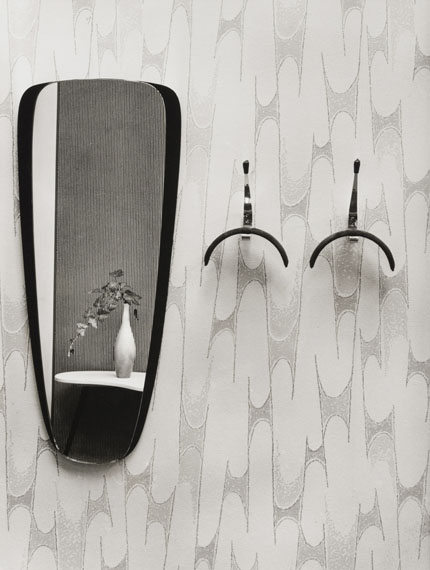
© Fotoarchiv Ruhr Museum Essen, 2019
courtesy Die Photographische Sammlung/SK Stiftung Kultur, Köln
"The Lobster Quadrille"
Photographs by Roselyne Titaud, Herbert Bayer, Jim Dine, Ruth Hallensleben, Willi Moegle, and Anonymous
Masters
An exhibition taking place as part of "Artist meets Archive" and the Internationale Photoszene Köln
Exhibition: 3 May – 21 July, 2019 in Room 3
Opening with artist talk and presentation of the book accompanying the show:
Sunday, 5 May, 2 pm
The French artist Roselyne Titaud (b.1977) does not present the photographic works she knows best in the exhibition she has curated and titled "The Lobster Quadrille," but instead takes up the challenge of unearthing lesser-known images. She focuses on "hidden treasures," discovering in them a new source of inspiration. Titaud has arranged this diverse set of works into a visual alphabet that offers fresh perspectives and possibilities for
interpretation. This explains the title she chose, which refers to a chapter from Lewis Carroll’s novel Alice in Wonderland in which various marine animals strike up a colorful round dance, changing partners to try out ever-new constellations. This open and dynamic system of references serves as a fitting metaphor for the artist’s exhibition concept.
Roselyne Titaud’s images afford us glimpses of the world of things in the form of the decorative or functional objects on display in private households. The color photographs of interiors and domestic still lifes were made for the most part in Berlin and France. Living spaces people create for themselves are thus at the heart of the photographer’s detailed examination. Her motifs tell us something about personal preferences and tastes but also
have a temporal component as memories of a particular moment. Many of Titaud’s images take us back to an era when the aesthetics and materials of furnishing fashions and styles were different than they are today. And the arrangements ultimately also reflect lifestyles and family relations, allowing us to infer emotional atmospheres and social structures as well as economic conditions. We discover here porcelain and glass in a variety of shapes and colors, as vases or fruit bowls for example; along with decorative lace or woven fabrics with varied patterns and fringe; cushions, throws, and coverlets on armchairs; glass cabinets; chests of drawers; and small tables on which objects are carefully displayed.
In Roselyne Titaud’s oeuvre, these private settings are correlated with certain forms of museum presentation, represented here by photographs taken in natural history museums. She for example did an eponymous photographic ensemble at the Museum Am Löwentor in Stuttgart in 2009. Artificial fish of all kinds populate the photographs of showcases she came upon there. In the dioramas, the color blue indicates a watery habitat, accompanied by a replicated sandy seabed and plants. The imagined world inhabited by the dinosaurs is also illustrated here, reconstructed based on fossils and leading us far back into the history of the planet earth. The artist juxtaposes these compositions sprung from human imagination with a collection recently acquired by Die Photographische Sammlung/SK Stiftung Kultur of shots of department store display windows dating from 1967 by unknown photographers.
The artificial world of goods seen here, with its outdated clothing tastes and fashions, seems alien and curious to us today—every bit as exotic as the museum panoramas of simulated animals and plants. "The anonymous photographs of Karstadt shop windows from the 1960s inspired me with their humor and lightheartedness. They also gave me the
urge to explore my own archives and bring to light again the photos from the Am Löwentor series," says Titaud. The shop window decorations from the 1960s breathe the same zeitgeist that can be found in many of the private still lifes photographed by Titaud.
The world of interior decoration is also on view in the black-and-white photographs the artist selected by Ruth Hallensleben (1898–1977), who is represented in the show with a project commissioned by a wallpaper company in Gummersbach, dating between 1954 and 1959. Hallensleben worked in Cologne from the mid-1930s to the 1960s as a successful industrial photographer. The photographs presented here show typical 1950s patterned wallpapers with geometric or plant forms. Included in the pictures as props are pieces of furniture such as an armchair or a wall mirror, all displaying the curvaceous lines popular at the time.
Titaud’s interest in furnishings is likewise reflected in the photographs she chose by Willi Moegle (1897–1989). Chairs and a table he depicted caught her attention. Moegle worked as an object and advertising photographer for numerous companies and was acclaimed for his formally strict and clearly composed images, which often highlight the sculptural qualities of objects. Roselyne Titaud displays these images alongside her 2009 series Éntendus, which shows sculptures from the 14th and 16th centuries in the Musée du Louvre, in most cases as details in small-format black-and-white photographs. This mode of representation creates a high degree of abstraction, lending the images a surreal look. The historical saint and Christ figures become pure form and surface, disintegrating into their constituent components—just as the artist Herbert Bayer (1900–1985) effectively fragmented himself in his self-portrait of 1932.
Roselyne Titaud studied at the École des Beaux-Arts in Saint-Étienne and has been living in Berlin for the last few years.
�
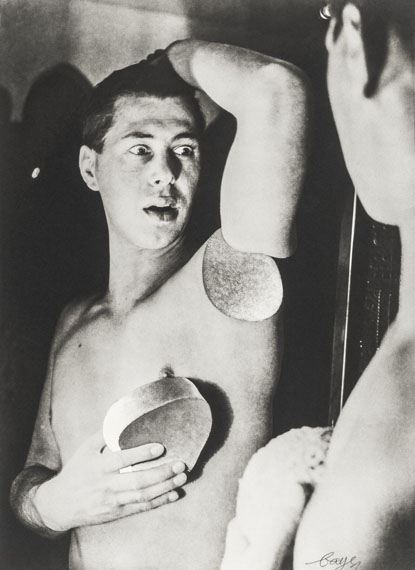
© VG Bild-Kunst, Bonn, 2019
courtesy Die Photographische Sammlung/SK Stiftung Kultur, Köln
"Die Hummer-Quadrille"
Photographien von Roselyne Titaud, Herbert Bayer, Jim Dine, Ruth Hallensleben, Willi Moegle und Anonyme
Eine Ausstellung im Rahmen von "Artist meets Archive" und der Internationalen Photoszene Köln
Ausstellung: 3. Mai bis 21. Juli 2019 in Raum 3
Eröffnung mit Künstlerinnengespräch und Vorstellung der ausstellungsbegleitenden Buchpublikation:
Sonntag, 5. Mai, 14 Uhr
Bewusst präsentiert die französische Künstlerin Roselyne Titaud (*1977) gerade nicht die vertrauten Werke in der von ihr kuratierten Ausstellung "Die Hummer-Quadrille", sondern findet in den unbekannteren Arbeiten eine Herausforderung. Es geht ihr insbesondere um die "verborgenen Schätze", die Seitenstränge der Sammlung, die sie als Impulsgeber entdeckt. Jedes noch so unterschiedliche Werk erweist sich für Titaud als Teil eines visuellen Alphabets, das veränderte Blickwinkel und Interpretationen ermöglicht.
Entsprechend versteht sich der von der Künstlerin gewählte Titel, der ein Kapitel aus Lewis Carrolls Roman Alice im Wunderland bezeichnet. Dort finden sich Meerestiere zum Tanz zusammen und führen einen bunten Reigen in immer neuen Konstellationen auf – ein offenes und dynamisches Bezugssystem, das sinnbildlich für das Ausstellungskonzept der
Künstlerin steht.
Roselyne Titauds Photographien führen in die Welt der Dinge und Gegenstände, wie sie vielfach als Dekorations- und Gebrauchsutensilien in privaten Wohnungen vorzufinden sind. Entstanden sind die Farbaufnahmen von Interieurs und Stillleben vorwiegend in Berlin und Frankreich. Es ist der vom Menschen gestaltete Lebensraum, den die Photographin eingehend untersucht. Ihre Motive geben Auskunft über persönliche Geschmäcker und Vorlieben, spielen auf Erinnerungsmomente an und weisen so eine besondere zeitliche Komponente auf. Titauds Bilder leiten oftmals weg von der Gegenwart in eine Zeit, als Einrichtungsmoden und -stile anderen ästhetischen und materiellen Parametern unterlagen. Und darüber hinaus spiegeln sich in den Arrangements Lebensvorstellungen und familiäre Beziehungen, die auf emotionale und gesellschaftliche Strukturen, auch wirtschaftliche Voraussetzungen schließen lassen. Porzellan und Glas in unterschiedlichen Formen und Farben, als Vasen oder Obstschalen gibt es zu entdecken ebenso wie dekorative Stoffe mit Mustern und Fransen, aus Spitze oder gewebt, Kissen, Überwürfe und Deckchen auf Sesseln, Vitrinen, Kommoden und kleinen Tischen, auf denen die Gegenstände drapiert sind.
Die Form des bedeutsamen privaten Arrangements korrespondiert in Roselyne Titauds Schaffen mit bestimmten musealen Präsentationsformen, umgesetzt in Aufnahmen naturkundlicher Museen. So ist 2009 im Museum Am Löwentor in Stuttgart ein gleichnamiges photographisches Ensemble entstanden. Künstliche Fische aller Art bevölkern die Aufnahmen der dort vorgefundenen Vitrinen. In den Dioramen ist etwa das Wasser als Lebensraum durch blaue Farbe angedeutet, sandiger Meeresboden und Pflanzen sind nachgebildet. Auch die imaginäre Welt der Dinosaurier wird veranschaulicht, eine Welt, die nur anhand von Funden rekonstruiert ist und weit zurück in die Geschichte des Planeten Erde führt.
Diese mehr der Welt der Imagination entsprungenen Zusammenstellungen konfrontiert die Künstlerin mit Schaufensteraufnahmen eines Kaufhauses aus dem Jahr 1967, ein jüngst in den Bestand der Photographischen Sammlung/SK Stiftung Kultur eingegangenes Konvolut, dessen Urheber bislang nicht bekannt ist bzw. sind. Die
künstliche Warenwelt, überholte Kleidungsgeschmäcker und Moden wirken aus heutiger Sicht befremdlich, fast kurios und so exotisch wie die musealen Vitrinenpräsentationen nachgebildeter Tiere und Pflanzen. "Die anonymen Photographien von Karstadt-Schaufenstern aus den 1960er-Jahren begeisterten mich durch ihren Humor und ihre Leichtigkeit. Auch gaben sie mir den Anstoß, mein eigenes Archiv zu druchforsten und Aufnahmen aus der Serie Am Löwentor zu Tage zu fördern"," sagt Titaut. Und nicht zuletzt atmen die Schaufensterdekorationen der 1960er-Jahre jenen Zeitgeist, der sich in zahlreichen der von Roselyne Titaud photographierten privaten Stillleben wiederfindet.
Die Welt der dekorativen Inneneinrichtungsstile zeigen auch die von der Künstlerin ausgewählten Schwarz-Weiß-Photographien von Ruth Hallensleben (1898–1977), die in der Ausstellung mit einer zwischen 1954 und 1959 entstandenen Auftragsarbeit für eine Gummersbacher Tapetenfirma vertreten ist. Hallensleben arbeitete seit Mitte der 1930er-Jahre von Köln aus erfolgreich als Industriephotographin, eine Tätigkeit, der sie bis in die 1960er-Jahre nachgegangen ist. Die hier vorgestellten Aufnahmen zeigen für die 1950er-Jahre typisch gemusterte Tapeten mit geometrischen Formen oder pflanzlich anmutenden Ornamenten. Mit ins Bild genommen hat Hallensleben je unterschiedliche Möbelstücke wie einen Sessel oder einen Wandspiegel, alles im geschwungenen Design dieser Jahre gehalten.
Auch in den Photographien von Willi Moegle (1897–1989) findet sich Titauds Interesse an Einrichtungsgegenständen wieder. Dargestellte Stühle und ein Tisch binden ihre Aufmerksamkeit. Als Sach- und Werbephotograph war Moegle für zahlreiche Unternehmen tätig und wurde für seine formstrengen und klar komponierten Darstellungen geschätzt, die oftmals skulpturale Eigenschaften ins Bild setzen. Roselyne Titaud assoziiert hier ihre Serie Éntendus von 2009, die Skulpturen aus dem 14. und 16. Jahrhundert im Musée du Louvre meist ausschnitthaft und in kleinformatigen Schwarz-Weiß-Aufnahmen zeigt. Durch diesen Darstellungsmodus entsteht ein hoher Abstraktionsgrad, der auch surreale Anklänge anspricht. Aus den nachgebildeten menschlichen Körpern der historischen Heiligen- und Christusfiguren werden reine Formen und Oberflächen, sie zerfallen quasi in einzelne Bestandteile – so wie dies der Künstler Herbert Bayer (1900–1985) in seinem Selbstportrait von 1932 effektvoll vollzogen hat.
Roselyne Titaud hat an der École des Beaux-arts in Saint-Étienne studiert und lebt seit einigen Jahren in Berlin.�
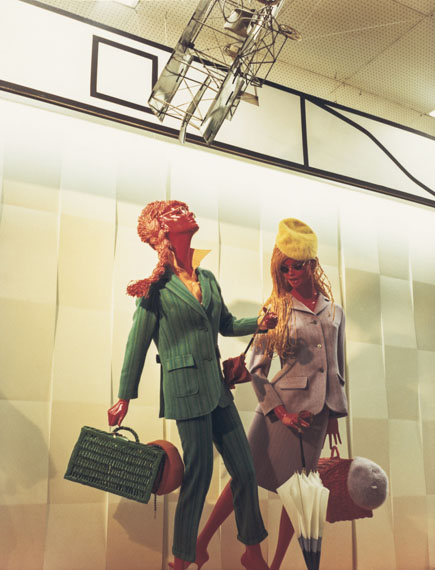
© courtesy Die Photographische Sammlung/SK Stiftung Kultur, Köln
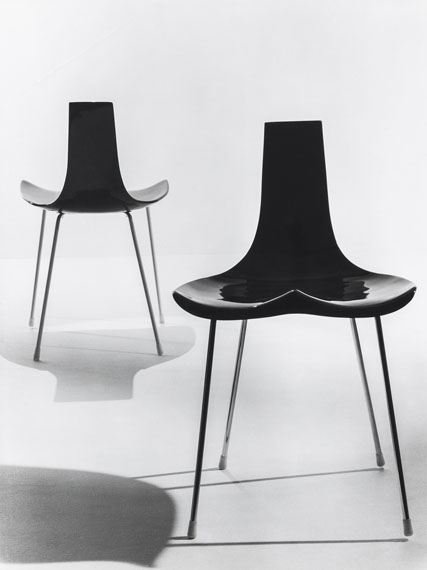
© bpk / Willi Moegle, 2019; courtesy Die Photographische Sammlung/SK Stiftung Kultur, Köln
